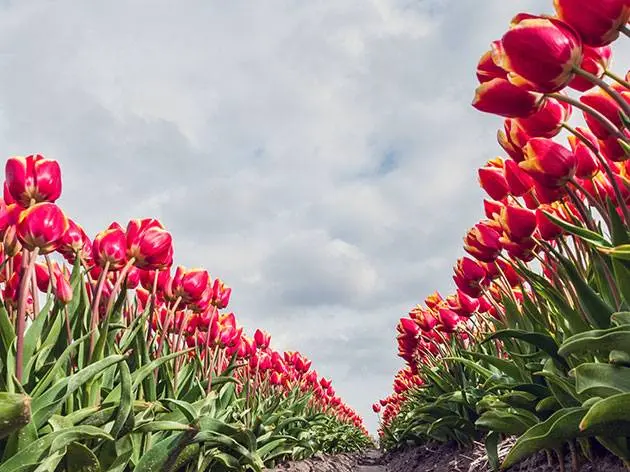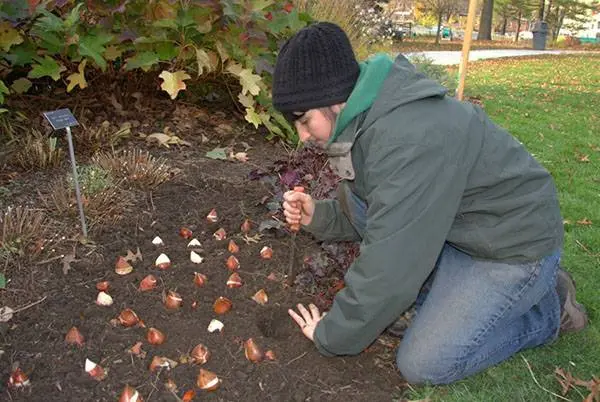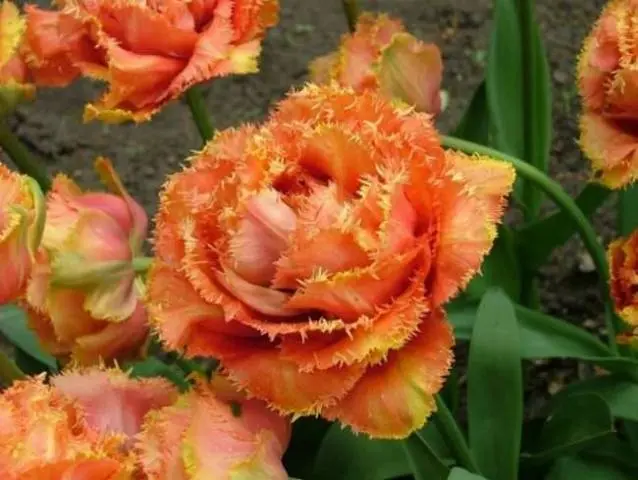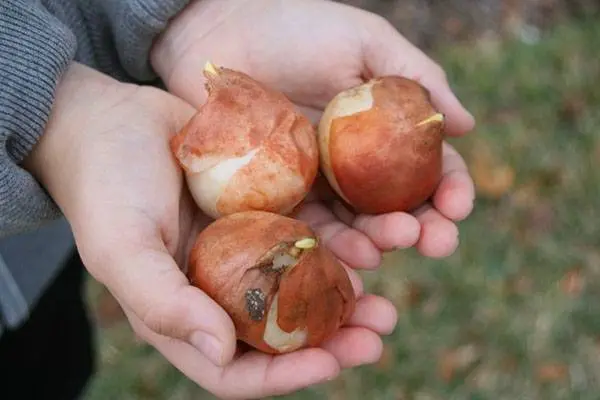Contents
It is not easy to grow any plants in Siberia. What can we say about flowers. Severe frosts can penetrate a meter and a half deep into the soil, creating the most difficult conditions for growing flower crops. Among the flowers, the most adapted to such harsh conditions were bulbous. Tulips are especially popular among flower growers. The main thing is to know how to plant tulips in the fall.

Timing of planting tulips in Siberia
Planting tulips in autumn in Siberia should be done at a strictly allotted time.
- The bulb should have time to form a fairly strong root system. It is thanks to her that they safely survive severe frosts, and by the first rays of the sun they immediately start growing. It takes about a month for the plant to form a powerful root system.
- If planting is done in late autumn, the bulbs will not have time to give roots, adaptation to the soil will not occur. When frosts, tulips planted late will disappear.
- If planted too early, when the soil is still warm, tulips may sprout. Such a plant will also not survive the winter.
- You need to carefully monitor the weather forecast in your area. As soon as the first frosts begin to be observed on the soil in the morning, and the temperature begins to drop to -3 -4 degrees, flower growers begin to plant bulbs. If we talk about Siberia – in general, this moment comes somewhere in the middle of September, although the period may vary depending on the regions.
Landing site selection and preparation
The site where tulips are supposed to be planted must be carefully selected and prepared. This is another condition for obtaining a rich harvest of flowers for the next year.

- To plant tulips in autumn in Siberia, you need to choose a secluded corner protected from cold winds for a flower bed. It is very good if a fence or a wall of the house closes the flower bed on the north side. The site should be open to sunlight, not darkened. If the tulips do not have enough sun, they will quickly wither, the flowers will form small and inconspicuous.
- You can plant tulips in acidic and heavy soil only by first adding manure or humus, wood ash for deoxidation, peat or sand to make it looser. Aeration of the place will increase, moisture will become less stagnant.
- Soil with high moisture capacity – most suitable for planting tulips. With a sufficient amount of nutrients, a strong root system is formed, as a result of which the plant has powerful sprouts, large flowers are formed.
- Soil pH from 6,5 to 7,6 – the most favorable conditions for tulips. Liming and adding chalk should be optimally combined with the introduction of peat. Otherwise, the acidity will increase too much, and you will not be able to get a decent harvest.
- If the soil is too loose and sandy, to create a more favorable environment, fertilizing, organic matter are constantly added to it, and frequent watering of tulips is arranged. This achieves an increase in the level of nutrients so necessary for plants.
- The heavy and too dense soil of Siberia prevents the access of oxygen to the bulbs. In addition, they begin to rot from constant moisture. Such soil is often loosened.
- The plants are planted in previously prepared soil. It is dug up about a week before planting. During this time, the earth will have time to settle. It is necessary to dig to the entire depth of the shovel – that is, 30-35 cm.
- The bulbs are carefully picked. It is necessary to remove all damaged or diseased specimens. There should not be any spots or dots on them; the seed material should be dense and evenly colored.
- A weak solution of potassium permanganate disinfects the bulbs. Soak them in it for about half an hour.
- Very often the bulbs attract rodents. To protect them in the winter, they put special poisoned baits. If there are pets in the country, such baits should be placed as far as possible from them.
Choosing the depth of planting tulips
When flower growers begin to plant tulips in the fall, everyone asks themselves the question: “how deep should the plant be buried?”. Indeed, in the difficult climatic conditions of Siberia, it is not easy for plantings to survive. Shallow depth will lead to the fact that the plantings will simply freeze out.
However, deep-planted bulbs take a long time to sprout, and sometimes they simply do not have enough strength to make their way to the sun. You should also take into account the fact that deep planting of tulip bulbs prevents the formation of children.
Before planting plants in the fall, you need to carefully examine the bulbs. In Siberia, pits are dug to a depth approximately equal to three diameters. However, too small bulbs are still planted at least 15 cm.
If the soil is heavy, this depth will suffice. For light soils, dig holes a little more – up to 20 cm deep. So, the plant will not be “beaten” by frost.

The choice of varieties for planting
The choice of tulip variety is given somewhat less attention than the preparation of the soil and the choice of a place for planting. Almost all varieties winter well and give strong seedlings with proper planting. More adapted to the harsh conditions of the north are bulbs of varieties:
- Hybrids – Dover, Diplomat, Parade.
- Terry early varieties – Dante, Bonanza, Carlton.
- Simple varieties – General de Vet, Diamond Star, Diana.
- Rembrandt Tulips – Black Boy.
These are mostly early flowering varieties. All of them are planted in the ground in the fall and have time to ripen before the onset of cold weather. Choose bulbs of medium and large diameter.

The planting process
Bulbs are planted on pre-prepared beds in several stages.
- Furrows are forming. The depth of each of them should reach 18-20 cm. A distance of 15-17 cm is maintained between the furrows. Sand is covered with a layer of about 3 cm at the bottom.
- Depending on the size of the bulbs, the distance between them can be from 7 cm (for small specimens) to 10 cm (for large ones).
- The best option would be to plant bulbs of different sizes mixed together. In this case, even with the loss of several bulbs, abundant flowering of tulips is ensured.
- Bulbs are sprinkled with manure or humus on top. Its layer should be approximately 4-5 cm.
- If the landing is made in dry weather, the tulips must be watered, but not very plentifully.
- The last layer is soil. It does not need to be compacted. The top layer is leveled with a special rake. To protect the plants from the upcoming frosts, later in the fall, the bed is covered with straw, branches or peat.
Storing bulbs before planting

From the conditions in which the bulbs are stored before planting, their long life and abundant flowering in the future also depend. During storage, future tulips should not dry out, rot, be eaten by rodents.
Immediately after digging, the remnants of the earth are removed from the bulbs, the roots are cut off. They need to be dried for several days, but too much exposure to the sun can damage the bulbs of everyone’s favorite flowers.
Boxes made of plastic or wood are also dried. Only healthy and dense specimens should be stored for storage, shifting them with paper or sawdust. Initially, they are stored at a temperature of 22 to 24 degrees. 1-2 weeks before planting, they are transferred to a colder place so that the plants adapt to low temperature conditions.
Features of growing tulips in Siberia
Due to difficult climatic conditions, flower growers in Siberia have to dig up bulbous flowers from the ground every year. If this is not done, they die, the plantings thicken, the flowers shrink.
Once the plants have faded and most of the leaves have disappeared, they can be dug up. In this strip, this moment occurs around the beginning of July. It is better to dig up tulips in not rainy weather.
Do not forget that tulip bulbs require careful sorting. Any hint of disease or rot should be put aside.
For those who are engaged in floriculture in the conditions of Siberia, an important role is played by the selection of plants that can endure and adapt to severe weather conditions. Tulips in this case are an excellent choice. They tolerate severe frosts well, bloom with the first rays of the sun, manage to bloom until the next autumn, which begins quite early. Do not be afraid to experiment – almost any variety can decorate a flower garden.









